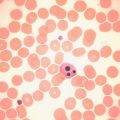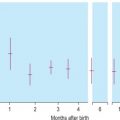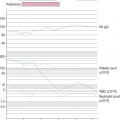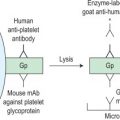Chapter Outline
Introduction to thrombophilia 410
Pre-analytical factors 411
Tests for the presence of a lupus anticoagulant 411
Dilute Russell’s viper venom time 412
Platelet neutralisation test 413
Kaolin clotting time 414
Dilute thromboplastin inhibition test 414
Investigation of inherited thrombotic states 415
Fibrinolytic system 419
Investigation of suspected dysfibrinogenaemia 419
Investigation of the fibrinolytic system: general considerations 419
Investigation of fibrinolysis 419
Investigation of suspected plasminogen defect or deficiency 419
Tissue plasminogen activator amidolytic assay 420
Plasminogen activator inhibitor activity assay 420
Plasminogen activator inhibitor antigen assay 421
Platelet ‘hyperreactivity’ and activation 421
Platelet activation: flow cytometry 421
Homocysteine 422
Markers of coagulation activation 422
Global assays of coagulation 422
Introduction to thrombophilia
Investigations to identify an acquired or inherited thrombotic tendency are most frequently carried out in patients who develop venous or arterial thrombosis at a young age, in those who have a strong family history of such events or have thrombosis at an unusual site and in individuals of all ages with recurrent episodes of thromboembolism. In recent years the utility of these tests, as judged by their ability to alter management, has come under scrutiny. In most cases the results of individual assays have a limited effect on decisions made on the basis of clinical history alone. This is partly because they are initiated in patients who have already had a thrombosis and have thus demonstrated their thrombotic tendency. Nonetheless there is still a need to identify those individuals whose risk of further thrombosis is sufficiently high to warrant long-term anticoagulation, and attention has turned to global tests of thrombotic potential and combinations of single traits as well as details of the clinical history. It should be remembered that many thromboses are almost entirely the result of circumstantial factors; these include trauma, fractures, surgery and an acute-phase inflammatory response. Further investigation of coagulation is often unnecessary in these circumstances. The investigations described here are most commonly instituted in venous thrombosis, but some unexplained arterial events, especially in young people or when paradoxical embolism is suspected, are also investigated. In general, the contribution of the inherited abnormalities of plasma coagulation factors is less evident for arterial than venous thrombosis because the aetiology is dominated by atherosclerosis.
In this chapter the investigations to detect an acquired thrombotic tendency are presented first, followed by a simplified battery of tests needed to establish the diagnosis of the more important inherited ‘thrombophilias’. Measurement of this small number of factors does not provide a complete assessment of the coagulation system, and the failure to detect one of the traits described does not indicate that the individual does not have an increased risk of thrombosis. An acquired thrombotic tendency is common and occurs in many conditions, but the aetiology is usually complex, multifactorial and not easily identifiable by a single laboratory test. The large number of traits identified, often with a small associated relative risk, makes their individual utility equally small. Until the interactions of these numerous factors are more completely understood, the clinical history remains a dominant factor in clinical management. The British Committee for Standards in Haematology has published guidelines on the investigation of inherited thrombophilia.
Pre-analytical factors
Testing during the acute phase of a thrombotic event is not recommended since acute inflammatory effects, comorbidities and consumptive effects can lead to misleading results. There is no evidence that the acute management of thrombosis requires alteration on the basis of these measurements, so they are best deferred until the patient’s condition is stable. The only exception is the development of purpura fulminans in children. Similarly the effects of anticoagulant therapy, pregnancy and oestrogen therapy on these tests should be borne in mind and avoided if possible.
Tests for the presence of a lupus anticoagulant
The lupus anticoagulant (LAC) is an acquired auto-antibody found both in association with other autoimmune disorders and in otherwise healthy individuals. LACs are immunoglobulins that bind to certain phospholipid-bound proteins. The effective sequestration of phospholipid can then cause prolongation of phospholipid-dependent coagulation tests such as the prothrombin time (PT) or the activated partial thromboplastin time (APTT). The name ‘anticoagulant’ is misleading because despite the in vitro effects, patients do not have a bleeding tendency. Instead, there is a clear association with recurrent venous thromboembolism, stroke and other arterial events and, in women, with recurrent abortions, fetal loss and other complications of pregnancy. Therefore tests for the presence of an LAC should be carried out in all individuals with unexplained venous or arterial thrombosis and also in women with recurrent early or late pregnancy loss. Antibodies of this class are members of a larger group called antiphospholipid or anticardiolipin antibodies (although not precisely the same, these terms are often used interchangeably). Tests for LAC are usually performed in parallel with tests for the presence of antiphospholipid antibodies. In general the latter are not performed by haematology laboratories and are therefore not described here. Serological tests for antiphospholipid antibodies are not yet standardised and agreement between laboratories is poor. A large number of target proteins have been described but the most important – and for which there is clear evidence of a pathogenetic effect – is β2 glycoprotein I. Prothrombin is another target for which there is weaker evidence of pathogenicity but which frequently contributes to the LAC effect. Increasingly, tests specifically for anti-β2 glycoprotein I antibodies are performed and possible mechanisms for their prothrombotic activity are being elucidated. ,
The presence of an LAC may be detected by the clotting screen and, depending on the reagents and methods used as well as on the potency and avidity of the antibody, the PT, APTT or both may be prolonged. However these tests may well be normal and, if clinically suspected, specific tests should always be performed.
Patients with an LAC may show other abnormalities, including thrombocytopenia, a positive direct antiglobulin test and a positive antinuclear antibody test. Although prothrombin is a frequent target for antiphospholipid antibodies these are only rarely sufficient to inhibit or deplete prothrombin activity. Such patients may have a bleeding tendency. Guidelines on investigations for LACs have been published , and recommend the following tests:
- 1.
Dilute Russell’s viper venom time (DRVVT) in conjunction with the platelet neutralisation test.
- 2.
An APTT test that has a low concentration of phospholipid and uses silica as an activator, thus making it sensitive to the presence of LAC.
There are a large number of additional tests that have in the past been successfully used for the detection of LAC, several of which are no longer recommended due to poor reproducibility, technical problems and lack of standardisation. The kaolin clotting time (KCT) and the dilute thromboplastin inhibition test are retained here because they are still widely used and thought to have some advantages by some authors. Although no single test is sufficiently sensitive to detect all LAC, readers are counselled against performing an excessive (more than two) number of tests because a large number of false positives will be obtained. The most recent guidelines for the optimal performance of testing for LAC have been well laid out and are summarised in Table 19-1 .
| (A) Blood collection |
| 1 . Blood collection before the start of any anticoagulant drug or a sufficient period after its discontinuation |
| 2 . Fresh venous blood in 0.109 M sodium citrate 9:1 |
| 3 . Double centrifugation |
| 4 . Quickly frozen plasma is required if LAC testing is postponed |
| 5 . Frozen plasma must be thawed at 37 °C. |
| (B) Choice of the test |
| 1 . Two tests based on different principles |
| 2 . DRVVT should be the first test considered |
| 3 . The second test should be a sensitive activated partial thromboplastin time (low phospholipids and silica as activator) |
| 4 . LAC should be considered as positive if one of the two tests gives a positive result. |
| (C) Mixing test |
| 1 . Pooled normal plasma (PNP) for mixing studies should ideally be prepared in house. Adequate commercial lyophilized or frozen PNP can alternatively be used |
| 2 . A 1:1 proportion of patient:PNP shall be used, without pre-incubation within 30 min |
| 3 . LAC cannot be conclusively determined if the thrombin time of the test plasma is significantly prolonged. |
| (D) Confirmatory test |
| 1 . Confirmatory test(s) must be performed by increasing the concentration of phospholipid content of the screening test(s) |
| 2 . Bilayer or hexagonal (II) phase phospholipid should be used to increase the concentration of PL. |
| (E) Expression of results |
| 1 . Results should be expressed as ratio of patient-to-PNP for all procedures (screening, mixing and confirmation). |
| (F) Transmission of results |
| 1 . A report with an explanation of the results should be given. |
Sample preparation
It is essential that all the samples of plasma tested for an LAC are as free of platelets as possible. This is achieved by further centrifugation of plasma at 2500 g for 10 min. A platelet count of less than 10 × 10 9 /l should be achieved. The plasma is centrifuged at room temperature to avoid platelet activation because the presence of platelet microvesicles can also invalidate the test. After separation, the plasma should be frozen at − 70 °C as soon as possible to prevent deterioration. Prior to testing, the frozen sample should be rapidly warmed to 37 °C in a water bath.
Dilute Russell’s viper venom time
Principle
Russell’s viper venom (RVV) activates factor X leading to a fibrin clot in the presence of factor V, prothrombin, phospholipid and calcium ions. An LAC prolongs the clotting time by binding to the phospholipid and preventing the action of RVV. Dilution of the venom and phospholipid makes it particularly sensitive for detecting an LAC. Because RVV activates factor X directly, defects of the contact system and factor VIII, IX and XI deficiencies do not influence the test. The DRVVT should be combined with a platelet/phospholipid neutralisation procedure to add specificity, and this is incorporated into several commercial kits.
Reagents
- •
Platelet-poor plasma. From the patient and a control (depleted of platelets by a second centrifugation) (p. 376).
- •
Glyoxaline buffer. 0.05 mol/l, pH 7.4 (p. 380).
- •
RVV (Stago, www.stago.com ). Stock solution: 1 mg/ml in saline. For working solution dilute approximately 1 in 200 in buffer. The working solution is stable at 4 °C for several hours.
- •
Phospholipid. Platelet substitute; also available commercially (e.g. Bell and Alton platelet substitute, www.diagen.co.uk ).
- •
CaCl 2 . 0.025 mol/l (p. 380).
Reagent preparation
The RVV concentration is adjusted to give a clotting time of 30–35 s when 0.1 ml of RVV is added to the mixture of 0.1 ml of normal plasma and 0.1 ml of undiluted phospholipid. The test is then repeated using doubling dilutions of phospholipid reagent. The last dilution of phospholipid, before the clotting time is prolonged by 2 s or more, is selected for the test (thus giving a clotting time of 35–37 s).
Method
Place 0.1 ml of pooled normal plasma and 0.1 ml of dilute phospholipid reagent in a glass tube at 37 °C. Add 0.1 ml of dilute RVV and, after warming for 30 s, add 0.1 ml of CaCl 2 . Record the clotting time. Repeat the sequence using the test plasma.
Interpretation
International guidelines suggest that the 99th centile (2.3 standard deviations for normally distributed data) should be used as a cut-off for definition of a prolonged DRVVT. UK guidelines point out that accurate determination of this limit may require > 120 normal samples, but that if established normal ranges are available this may be possible with a smaller number of 20–60 samples. ,
Prolongation of the DRVVT may indicate the presence of an LAC but could also arise from an abnormality of factors II, V or X or fibrinogen or the presence of some other inhibitor. The presence of an inhibitor can be confirmed by testing a mixture of equal volumes of the patient’s and control plasma, whereas phospholipid dependence can be confirmed by using the platelet neutralisation test described below. Mixing with normal plasma corrects an abnormal DRVVT caused by a factor deficiency or defect, but should not do so in the presence of an LAC, although the effect of dilution may overcome a weak inhibitor. The platelet or phospholipid neutralisation procedure shortens the clotting time in the DRVVT test when this is prolonged due to an LAC (see below).
Platelet neutralisation test
Principle
When an excess of phospholipid, originally in the form of lysed platelets, is added to clotting tests, the tests become insensitive to the presence of an LAC. This appears to be a result of the ability of the platelets/phospholipid to adsorb the LAC. Platelet neutralisation reagents are available commercially and are usually provided in DRVVT kits. Commercial reagents are preferred for consistency but a method for preparation is provided below. To utilise this property of platelets, they must be washed to remove contaminating plasma proteins and activated or ‘fractured’ to expose their coagulation factor binding sites.
Reagents for preparation of platelet neutralisation reagent
- •
Acid–citrate–dextrose (ACD) anticoagulant solution (p. 561) pH 5.4, is required for washed platelets. For use, 6 parts of blood is added to 1 part of this anticoagulant.
- •
Na 2 EDTA. 0.1 mol/l in saline.
- •
Calcium-free Tyrode’s buffer. Dissolve 8 g NaCl, 0.2 g KCl, 0.625 g Na 2 HPO 4 , 0.415 g MgCl 2 and 1.0 g NaHCO 2 in 1 litre of water. Adjust pH if necessary to 6.5 with 1 mol/l HCl.
Method
Collect normal blood into ACD and centrifuge at 270 g for 10 min. Pipette the supernatant platelet-rich plasma (PRP) into a plastic container, and centrifuge again to obtain more PRP, which is added to the first lot. Dilute the PRP with an equal volume of the calcium-free buffer, and add one-tenth volume of ethylenediaminetetra-acetic acid (EDTA) to give a final concentration of 0.01 mol/l. Centrifuge the mixture in a conical or round-bottom tube at 2000 g for 10 min, and discard the supernatant. Gently resuspend the platelet pellet in buffer and 0.01 mol/l EDTA. Centrifuge again, discard the supernatant and resuspend the pellet in buffer alone. Then centrifuge the platelets a third time and resuspend the pellet in buffer without EDTA to give a platelet count of at least 400 × 10 9 /l. The washed platelets may be stored below − 20 °C in volumes of 1–2 ml. Before use, they must be activated by thawing and refreezing 3–4 times.
Use the washed platelets or the commercial reagent in the DRVVT test or in the APTT in place of the usual phospholipid reagent. First, determine a suitable dilution by testing a range of doubling dilutions in the test system with control plasma. A suitable dilution gives a similar clotting time to that obtained using control plasma and the phospholipid reagent.
Interpretation
The addition of platelets or a commercial ‘confirm’ phospholipid reagent to the DRVVT system corrects the clotting time when prolongation is caused by an LAC. It does not correct the time when the prolongation is due to a factor deficiency or an inhibitor directed against a specific coagulation factor. However, the ability of different batches of platelets to perform this correction is variable and may vary further with storage. Accordingly, each time the test is performed a plasma sample known to contain an LAC should be tested in parallel to establish the efficacy of the platelets. Many commercial kits are now available for performing the tests described above.
Each batch of tests should be performed in parallel with a pooled normal plasma control. The DRVVT of commercial normal plasmas should be close to the mid-point of locally derived normal ranges. The degree of correction produced by addition of excess phospholipid must take into account the normal plasma result and ideally the extent to which it is affected by the addition of excess phospholipid. One survey of reagents found that the best discriminator of positivity was by using a normalised correction ratio (CR) of DRVVT clotting times as follows:
CR = P D N D − P C N C P D N D
Stay updated, free articles. Join our Telegram channel

Full access? Get Clinical Tree








